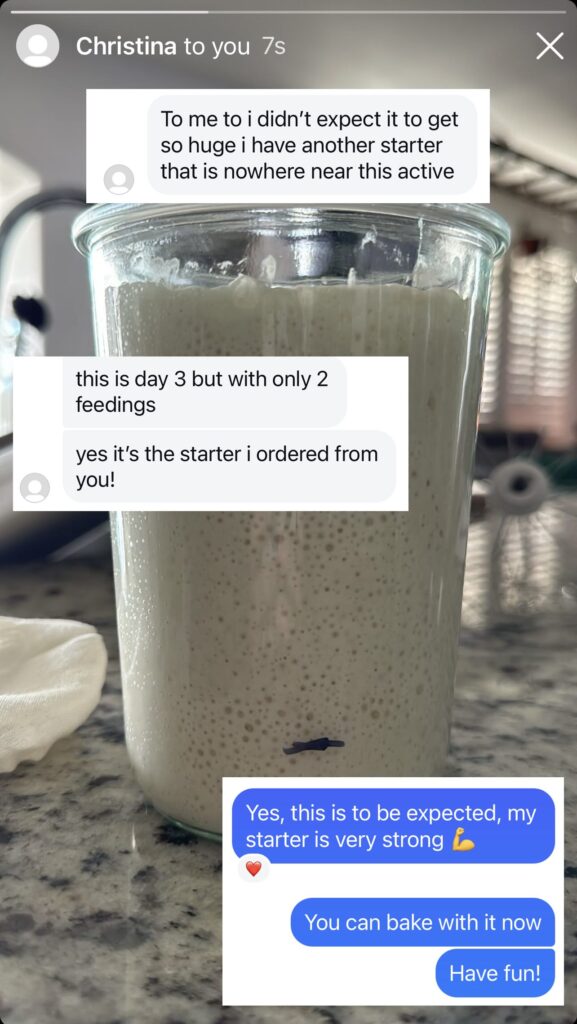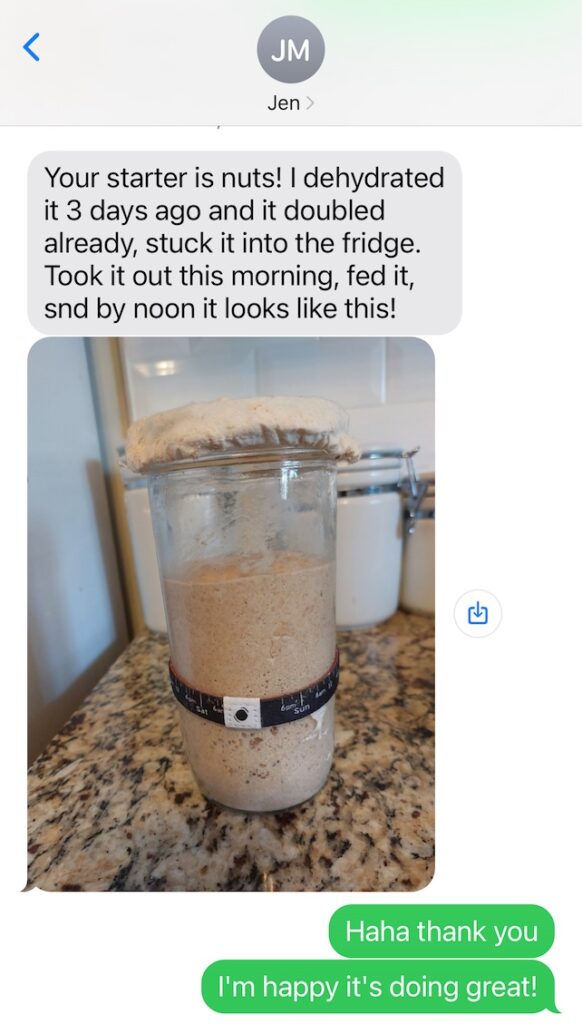You may have wondered how to use your sourdough starter in sourdough bread recipes and still have some leftover to keep the starter going.
There’s 2 methods.
Method 1 – Making Levains
Now this is kind of repetitive, since levain is just the french word for starter. But basically, when you use this method, you clone your starter, feed the clone, and the clone is what you use in your sourdough recipe.
The levain is the clone starter you will use for that particular recipe.
Your original starter is the mother starter that you will keep feeding to keep it going.
For example:
Let’s take this Country Sourdough Bread Recipe:
| Ingredients | Weight | Percentages |
| White Bread Flour | 400g | 80% of the flour |
| Whole Wheat Flour | 100g | 20% of the flour |
| Water | 360g | 360/500 = 72% hydration |
| Sourdough Starter | 100g | 100/500 = 20% starter |
| Salt | 10g | 10/500 = 2% salt |
We will need 100g of sourdough starter to make 1 sourdough bread
To make the levain for this recipe, here’s how you would go about doing that:
| starter | flour | water | total | |
| Feeding Ratio | 1 | 1 | 1 | |
| Feeding 1 | 25g | 50g | 50g | 125g |
You take 25g of starter from your mother starter (put your mother starter back where you keep it), feed the 25g of starter 50g of flour and 50g of water.
What you will get is 125g of new sourdough starter (your levain).
From that, you use 100g for your recipe.
Whatever is leftover you add back to your mother starter jar. But you might not even have anything leftover since it may be stuck around the sides of the jar, etc.
That is why it’s important that when you are feeding your sourdough starter in preparation to make a sourdough bread recipe, that you feed it a little extra.
Method 2 – No Discard method
(Using the mother starter, instead of making levains)
I like this method because it’s less dishes to wash.
Let’s say your recipe calls for 100g of starter.
And let’s say that you maintain a small mother starter, around 50g total.
Simply feed your starter at a 1 : 1 : 1 ratio.
That looks like this:
| starter | flour | water | total | |
| Feeding Ratio | 1 | 1 | 1 | |
| Feeding 1 | 50g | 50g | 50g | 150g |
You take your original starter (50g), and add 50g of flour and 50g of water. Equal parts starter, flour, and water. 1 : 1 : 1
After this, you should have 150g of new starter in your jar.
When you starters comes to peak, take 100g of the starter and use that for your recipe.
What you have left in your jar is now 50g of starter, what you started out with.
The starter increases in volume, not mass.
The starter stays the same weight while it’s coming to peak.
When you think about that, it’s easy knowing how much to feed your starter so that you have 1) enough starter for a recipe, and 2) have some left over so you can keep your starter going.
If you have to, talk it thru:
- you maintain 50g of starter
- you need 100g to make your recipe
- you want 50g of starter left over
- you need to turn 50g of starter into 150g of starter
- 150 divided by 3 equal parts (starter, flour, water) is 50g
- that is 50g starter + 50g flour + 50g water = 150g starter
- take 100g of starter for your recipe
- leaving 50g of starter to live on
How much starter do I need to keep?
I like to maintain a relatively small starter and adjust my feeding ratios to match my needs.
I like to do this because it saves money.
I maintain a 50g starter and just scale up my feeding ratios to match what is needed for a recipe. This way, I use the minimum amount of flour while still keeping the starter active and happy.
This is where Baker’s Percentages really help you
I used to be really intimidated with baker’s percentages, but I promise you, once you embrace it, it makes sourdough baking so so so much easier.
At least that’s how it was for me.
With baker’s percentages, you can totally deconstruct a recipe and adjust measurement, or rather, ratios, to tweak any recipe.
It lets you easily scale up or down any sourdough recipe.
It lets you easily figure out how much flour and water to feed your starter.
It’s just a good, helpful tool.



Hi,
Have couple of doubts please.
1) what’s the room temperature where the starter is kept. Asking since here the temperature is around 30-35 degree and I find my starter tripling fast.
So do you suggest I feed it twice a day or increase the ratio.
2) Does using the starter with 1:1:1 ratio or 1:5:5 ratio have any impact on oven spring or the bread crumb etc.
woukd really appreciate if you could guide.
Thanks
Th
1) So your starter peaks fast at 86-90F, I often put my starter in my proofer at around that, even more, around 97F. It’s fine. If you cannot use it in time, just scale up the feeding, to 1:5:5 or more
2) Does the feeding ratio have an effect on the sourdough bread itself? That’s up for debate. I’m in the boat that it does. I believe that a starter that’s feed at higher feeding ratios results in better tasting, better looking and less sour bread, often better, predictable fermentation times.